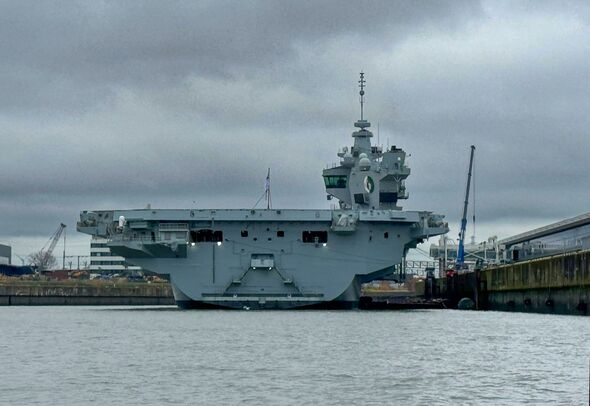A drone came within 250 metres of HMS Queen Elizabeth, the Royal Navy’s flagship aircraft carrier, prompting a criminal investigation into the illegal use of unmanned aerial vehicles near sensitive military sites.
The incident, revealed by Lord Coaker, Minister of State in the Ministry of Defence, occurred on November 22 as the carrier entered Hamburg port.
It comes against a backdrop of heightened tensions between Russia and the West, with Moscow likely to fall under suspicion given its extensive use of drone warfare in Ukraine. Parliamentarians have warned that these incursions pose serious risks to Britain’s critical infrastructure, including military bases, power stations, and transport hubs.
Lord Coaker informed the House of Lords that the investigation into this and other recent drone incursions is being led by the Ministry of Defence Police in collaboration with the United States Air Force (USAF) and civilian authorities.
This follows illegal drone activity over American airbases at RAF Lakenheath and RAF Mildenhall in Suffolk, and RAF Feltwell in Norfolk.
Lord Coaker said: “It is illegal for drones to be flown near or within the vicinity of these military sites, and people should be aware of that. We will work with civil authorities to prosecute those responsible.
All agencies of the state will work to identify and address these acts.” He confirmed that those found guilty could face up to 14 years in prison under national security legislation.
Labour peer Viscount Stansgate raised the alarm in Westminster, describing the HMS Queen Elizabeth incident and the wider pattern of activity as “potentially serious” in light of the growing use of drones in modern warfare.
“It may be that these flights are not a coincidence.
“Does the minister agree that these matters are of serious concern, given that drones are now ubiquitous, and we know what their role is in warfare?
“The House will remember that Gatwick Airport was completely closed a few years ago by unidentified drones.”
He called for stronger measures to address the growing threat to critical national infrastructure.
Lord Coaker acknowledged the concerns, assuring the House that the Ministry of Defence is treating the issue with urgency and has implemented “robust measures” at its sites, including counter-drone capabilities.
He added: “We take this matter seriously and work closely to ensure the safety of all our sites.”
He also reassured peers that efforts were ongoing to strengthen protections across Britain’s defence network.
Referring specifically to the aircraft carrier, he noted: “A civilian drone was observed in the vicinity on November 22; it got no closer than 250 metres from HMS Queen Elizabeth.”
Former Chief of Defence Staff, Lord Stirrup, emphasised the broader implications of the incursions, noting that drones have been widely deployed in Ukraine to target civilian infrastructure.
He said: “This is not just a question of defence sites but of much wider national resilience.
“We can’t mount air defence systems around every single part of our critical national infrastructure. We have to ensure we have some other method of protecting against this new threat.”
He urged the government to adopt a more comprehensive approach, considering the risks posed to non-military targets such as power grids and communication systems.
In response, Lord Coaker confirmed that the government is evaluating broader security measures, though he did not specify new initiatives.
He explained: “We are aware of the increasing threats posed by drones,” he said, reiterating that all relevant agencies were collaborating to prevent future incursions.
The USAF, while stating that the drones near its bases were not confirmed as hostile, has also expressed concern about the repeated breaches of restricted airspace.
This surge in drone activity has reignited parliamentary debate about the adequacy of the UK’s defences against modern technological threats.
With tensions with Russia at a high, the government faces increasing pressure to ensure that Britain’s military and civilian infrastructure are protected from emerging forms of surveillance and sabotage.
